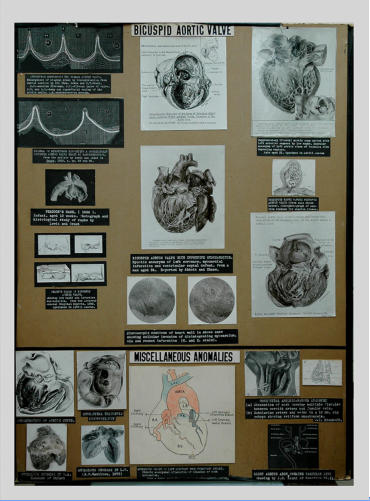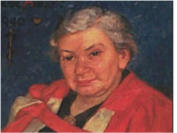


Disclaimer Privacy Policy
Copyright (c) 2021 Bicuspid Aortic Foundation, All Rights Reserved


Creating a Climate of Hope, an Atmosphere of Caring, and Information for All

Honoring a Pioneer
Dr. M. E. Abbott
Source: Museum Regional Argenteuil, museearg.com Dr. M. E. Abbott devoted much of her work to congenital heart disease, including bicuspid aortic valve.
Honoring the Work of Dr. M. E. Abbott
Like most families, we had never heard of a bicuspid aortic valve.
When I was told my husband was born with BAV,
and years later told he had an aneurysm of the aorta above his heart,
I thought I must have married a man with a very rare condition.
It was surprising to me to learn that BAV was a common, well-known heart defect, identified long
ago (drawn by Leonardo da Vinci). I wondered why BAV was not more visible to the public, since it
is the most common heart defect present at birth.
We were told when his BAV was replaced, that my husband was "fixed", implying there was nothing
else to be concerned about. Later, when my husband was diagnosed with an ascending aortic
aneurysm, we were shaken. No longer could we believe that he was "fixed" for life. And we
wondered why no one had warned us, no one had told us he was at risk from a bulging aorta. The
bulge had already been there at the time of his valve surgery, but we were never told. It had grown
silently, without our knowledge.
The story of BAV in the medical literature includes a paper from 1928 by Abbott. For some time, I
wondered who Dr. Abbott was. Today, I have this entire paper from 1928, as well as Dr. Abbott's
Atlas of Congenital Heart Disease, in my possession. They are rich treasures, written by this woman
of amazing genius, who was an extraordinary, gifted physician.
Dr. Maude Abbott understood and published something very important in 1928 - something just
beginning to dawn on medicine today:
"The presence of a bicuspid aortic valve appears to indicate, at least in a portion of the cases in
which it occurs, a tendency to spontaneous rupture of the aorta, which hangs always, like a sword
of Damocles, above the unsuspecting subjects of this type of coarctation.... it seems probable that
the thinning, which is not infrequently seen in the wall of the ascending aorta in these cases,
may also be of congenital origin and due to the same arrest of development that lead to an
incomplete evolution of the endocardial cushions destined to become the aortic cusps. That
such a thinned area would yield the more readily to form a dissecting aneurysm, with later rupture
under the increased pressure that exists in the upper body in adult coarctation, would appear to be
self-evident. Extension of such a congenital weakening of the media to the whole arterial
system might similarly explain the coincidence of cerebral hemorrhage and such a process
might even have a part in the peculiar changes at the area of coarctation itself."(from Abbott:
Coarctation of the Aorta, American Heart Journal, Volume 3, 1928) (see The Natural and Modified
History of Congenital Heart Disease.)
Today, Dr. Abbott speaks across the decades through her published work. Her meticulously
documented study of her own cases and that of others sheds great light upon those with BAV and
associated vascular weakness. Having cared for these patients in life and examined through
autopsy their bodies after death, she understood a great deal through this incontrovertible evidence
about the nature of BAV and TAD.
From her writing, we can conclude that if still with us today, she would have understood what my
family, and other BAV families everywhere, have experienced. She would not have been surprised
by the aneurysm of my husband's ascending aorta, nor by Carrie Mettler's brain aneurysm. BAV
should be a red flag for these things, but they were shocks to us.
Tragically, the technology was not available in Dr. Abbott's day to help those with BAV/TAD very
much. Carefully studied, compassionately cared for, the patients died. No blood pressure medicine,
no antibiotics, no echocardiogram, MRI, or CT, no heart lung machine, no valve replacement - the
current era's wonders were not yet available.
Dr. Abbot's wisdom remains with us, as relevant now as when she first published her work.
It is our privilege to highlight it's importance today.
Dr. Maude Abbott has been called the "Canadian Queen of Cardiology". In 2013, sixty-three years
after after her death, we honor her as our "Queen of BAV Hearts".
Together let us
safeguard life-saving
knowledge and advancements in medicine,
and let us support the pioneering physicians
who help us today,
creating a climate of hope.
- Arlys Velebir, Bicuspid Aortic Foundation President


Poster on BAV by Dr.
Maude Abbott, part of her
large collection of work
on congenital heart
disease displayed in 1932
at the Centenary British
Medical Association
Meeting, London. Source:
Achives De Montreal,
ville.montreal.qc.ca


- Aorta
- BAV and Other Heart Valves
- Blood Pressure
- Exercise/Weight Lifting
- Featured Papers
- Guidelines
- Familial TAAD
- History
- Honoring Dr. M.E. Abbott
- Pictures (graphic content)
- Pictures Valvular Strand, Aneurysm (graphic)
- Prosthetic Heart Valves
- Scientific Awards
- Spotlight on Research - Coming Soon
- Video (graphic content)






















